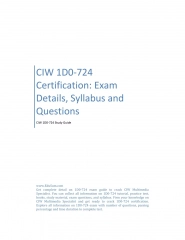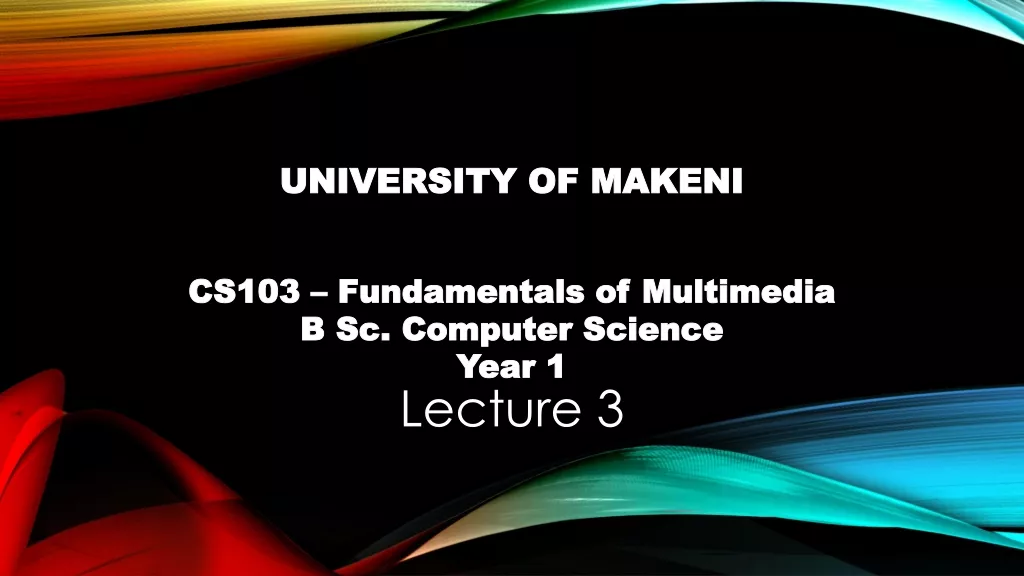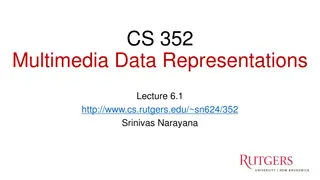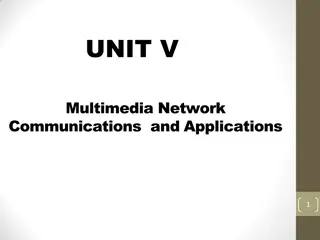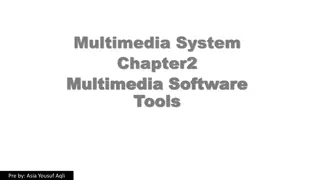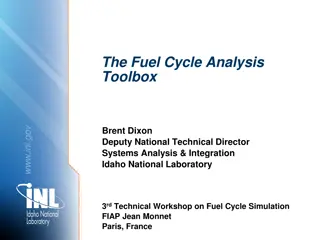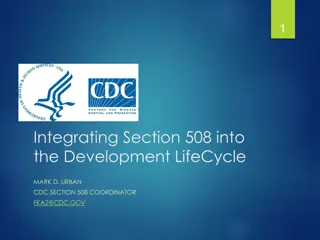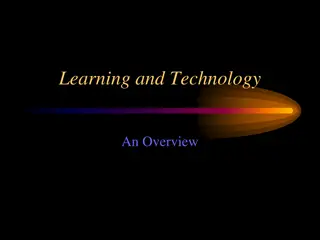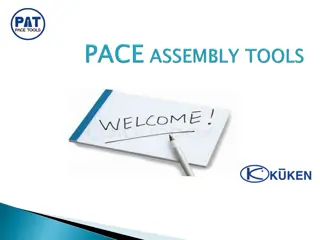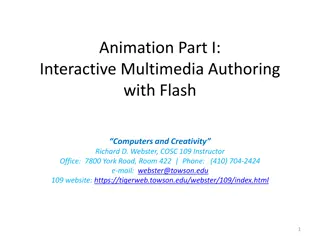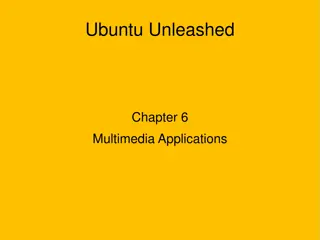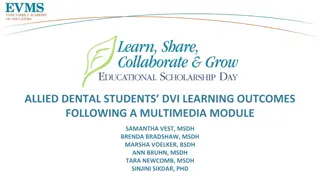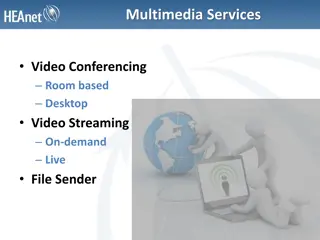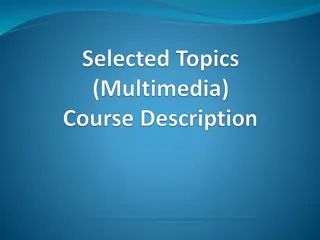
Mastering Multimedia Authoring Tools: A Comprehensive Overview
Dive into the world of multimedia authoring tools with this detailed exploration of types, features, and perspectives. Discover how authoring systems organize and edit multimedia elements, support scripting for advanced applications, and cater to both technical and non-technical users. Uncover the four main perspectives in multimedia authoring tools and learn about the key features that empower developers and end-users alike.
Download Presentation

Please find below an Image/Link to download the presentation.
The content on the website is provided AS IS for your information and personal use only. It may not be sold, licensed, or shared on other websites without obtaining consent from the author. Download presentation by click this link. If you encounter any issues during the download, it is possible that the publisher has removed the file from their server.
E N D
Presentation Transcript
Introduction to multimedia authoring tools. Types of authoring tools. Cross-platform authoring notes.
Multimedia authoring tools provide the framework for organizing and editing the elements of a multimedia project. Text Graphic Audio Authoring Tools Authoring software provides an integrated environment for combining the content and functions of a project. Video Animation It enables the developer to create, edit, and import data.
Most authoring systems also support a scripting language for more sophisticated applications. Authoring tools require less technical knowledge to master and are used exclusively for applications that present a mixture of textual, graphical, and audio data.
Four main perspectives in multimedia authoring tools: Tool (any software package that could authors multimedia product) Product (the result of combining all multimedia components) Developer (designers, programmers, and multimedia authors) End user (customer or viewer)
Authoring system in multimedia. Features of authoring tools.
In multimedia authoring systems, multimedia elements and events are often regarded as objects. Objects exist in a hierarchical order of parent and child relationships. Each object is assigned properties and modifiers. On receiving messages, objects perform tasks depending on the properties and modifiers.
Editing and organizing features. Programming features. Interactivity features. Performance tuning and playback features. Delivery, cross-platform, and Internet playability features.
Authoring systems include editing tools to create, edit, and convert multimedia elements such as animation and video clips. The organization, design, and production process for multimedia involves storyboarding and flowcharting. Visual flowcharting or overview facility illustrates project structure at a macro level.
Visual programming with icons or objects is the simplest and easiest authoring process. Visual authoring tools such as Authorware and IconAuthor are suitable for slide shows and presentations. Authoring tools offer very high level language (VHLL) or interpreted scripting environment.
Interactivity gives the end user control over the content and flow of information in a project. Simple branching is the ability to go to another section of the multimedia production. Conditional branching is an activity based on the results of IF-THEN decisions or events. Structured language supports complex programming logic, subroutines, event tracking, and message passing among objects and elements.
Achieving synchronization is difficult, considering that performance of the different computers used for multimedia development and delivery varies. Authoring system should facilitate precise timing of events. It should enable developers to build a part of a project and then test it immediately.
Delivering the project may require building a run-time version of the project, using the multimedia authoring software. Run-time version or standalone allows a project to play back without the complete authoring software and all its tools and editors. It is important to use tools that facilitate easy transfer across platforms. Authoring systems provide a means for converting their output to be delivered within the context of HTML or DHTML.
Card- and page-based tools. Icon-based, event-driven tools. Time-based tools.
Card- and page-based authoring systems provide a simple and easily understood metaphor for organizing multimedia elements. Cards are developed that have different elements associated with them and are put in stacks. It contains media objects such as buttons, text fields, and graphic objects. It provides a facility for linking objects to pages or cards. You can link the cards by allowing the user to click on buttons or other elements and jump to a different card in the stack. Example : Hypercard, ToolBook, HyperNext Studio, Hyper Studio, PhytonCard, Revolution
Advantage Easy to understand metaphor 1 screen = 1 card = 1 page Easy to used Provide template Short development time Disadvantage Some run only on one platform Tools are not powerful / stand-alone
Icon-based, event-driven tools provide a visual programming approach to organize and present multimedia. Multimedia elements and interaction cues are organized as objects in a flowchart. Flowchart can be built by dragging appropriate icons from a library, and then adding the content. With icon-based programs, you use symbols in a flowchart scheme. Each icon represents a particular event.
An advantage of icon-based programs is that you can easily see how a title is structured, that is, the flow of a program and especially the branching. Example : Multimedia Authoware
Advantages Clear structure Easy editing and updating Disadvantages Difficult to learn Expensive
Time-based tools are best suited for messages with a beginning and an end. Some time-based tools facilitate navigation and interactive control. Time Based Authoring Programs use a movie metaphor. Like a movie on videotape, you start the multimedia title and it plays until some action causes it to pause or stop. Macromedia s Director and Flash are time-based development environments.
Macromedia Director: A multimedia database, Cast , contains still images, sound files, text, shapes, scripts, movies, and other Director files. Score is a sequencer for displaying, animating, and playing Cast members. Lingo is an object-oriented scripting language that enables interactivity and programmed control.
Advantages Good for creating animation Branching, user control, interactivity Disadvantages Expensive Steep learning curve for advances features
Macromedia Flash: Flash is used for delivering rich multimedia content to the Web. It allows the creation of simple static HTML pages with the Flash Player plug-in.
Advantages Easy to put animation and interactive movies Interactive menus Disadvantages Increase in file size Music and sound files embedded in Flash movies increase file sizes and increases the download time
Macintosh and Windows computers use different schemes to manage text and colors. While using text fields, ensure that the text displays correctly on both platforms. Outline and shadow styles on text should be avoided on Macintosh since they are not currently supported in Windows.
Multimedia authoring tools provide the framework needed for organizing and editing multimedia elements in a project. The three types of authoring tools are card- or page-based, icon-based or event-driven, and time-based. Text and color compatibility must be verified before moving multimedia projects across platforms.

